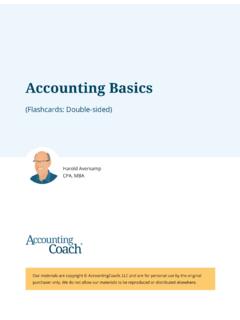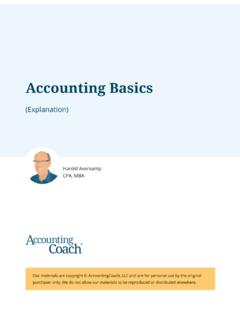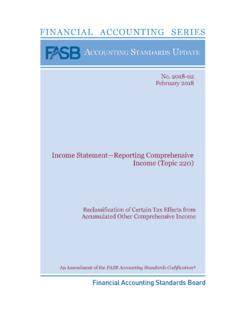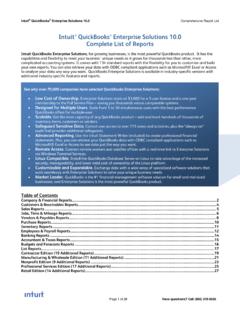Transcription of Accounting Cheat Sheet
1 Your accountingcoach PRO membership includes lifetime access to all of our a quick tour by visiting Cheat SheetFor personal use by the original purchaser only. Copyright accountingcoach . of Contents (click to navigate)Financial StatementsBalance SheetIncome StatementCash Flow StatementStockholders EquityFinancial RatiosAccounting PrinciplesBookkeeping, Debits & CreditsAccounting EquationAdjusting EntriesBank ReconciliationPetty CashAccounts Receivable & Bad Debts Expense Inventory & Cost of Goods SoldDepreciationAccounts PayableCost Behavior & Break-even PointPayroll AccountingStandard CostingAccounting s Accounting Cheat Sheet is a quick reference and overview of Accounting concepts. You should consult a professional accountant and/or the Accounting profession s official pronouncements for specific situations and for more complete personal use by the original purchaser only.
2 Copyright accountingcoach . StatementsFinancial statements are general purpose, external financial statements prepared according to generally accepted Accounting principles. Some terms that apply to the financial statements include:balance Sheet reports the amounts of assets, liabilities, and stockholders equity at a specified moment, such as midnight of December 31; also known as the statement of financial statement reports revenues, expenses, gains, losses, and net income during the period of time stated in its heading; also known as the statement of operations and as the profit and loss (P&L) of cash flows reports the changes in cash and cash equivalents during a period of time according to three activities: operating, investing, and of stockholders equity reports the changes in the components of stockholders equity, including net income, other comprehensive income, dividends, exercise of stock options.
3 Interim financial statements issued between the annual financial statements, financial statements independent CPA firm gives assurance about reasonableness and compliance with Accounting reporting includes financial statements, annual and quarterly reports to SEC and stockholders, press releases and other financial reports. Note: To learn more about Financial Statements see our Video Seminar, Visual Tutorial and Exam Questions in accountingcoach personal use by the original purchaser only. Copyright accountingcoach . SheetThe balance Sheet or statement of financial position reports assets, liabilities, owner s or stockholders equity at a point in time. Some terms that apply to balance sheets include: assets resources, things owned, and prepaid or deferred expenses; examples include cash, accounts receivable, inventory, prepaid insurance, land, equipment, vehicles, obligations and deferred revenues; examples include accounts payable, loans payable, wages payable, interest payable, customer deposits, deferred s equity a sole proprietorship s assets minus its equity a corporation s assets minus its liabilities; reports paid-in capital, retained earnings, and treasury equation Assets = Liabilities + Stockholders (Owner s) balance Sheet groups assets into the following classification: current assets, investments, property, plant and equipment, and other assets.
4 Liabilities are classified as either current or long-term. current asset will turn to cash within one year of the date of the balance Sheet (unless the operating cycle is greater than one year).current liability an obligation that will become due within one year of the balance Sheet date (unless the operating cycle is greater than one year). Note: To learn more about the Balance Sheet see our Explanation, Quiz, Puzzles, and Q&A for this topic on Also see our Visual Tutorial and Exam Questions in accountingcoach personal use by the original purchaser only. Copyright accountingcoach . StatementThe income statement (statement of operations, or P&L for profit and loss statement) reports a company s net income for a specified period of time. Net income is revenues and gains minus expenses and losses. Some terms associated with the income statement include:revenues amounts earned, sales, service fees, interest costs incurred to earn revenues, costs used up or expiring during the Accounting period, and costs for which the future value cannot be sale of a long-term asset for more than its carrying (book) value; elimination of an obligation for less than its carrying sale of a long-term asset for less than its carrying (book) value.
5 Elimination of an obligation for more than its carrying profit sales minus cost of goods of goods sold beginning finished goods inventory + net purchases (or cost of goods manufactured) ending finished goods income statement one subtraction to reach net income: operating and nonoperating revenues minus operating (including cost of goods sold) and nonoperating income statement at least one subtotal before reaching net income: sales cost of goods sold = gross profit; gross profit operating expenses = income from operations. Income from operations +/- nonoperating items = net , general and administrative SG&A; operating expenses; noninventoriable income income from operations; pretax income before nonoperating revenues and income income from peripheral activities. Note: To learn more about the Income Statement see our Explanation, Quiz, Puzzles, and Q&A for this topic on Also see our Visual Tutorial and Exam Questions in accountingcoach personal use by the original purchaser only.
6 Copyright accountingcoach . Flow StatementThe statement of cash flows (or cash flow statement) summarizes the significant reasons for the change in a company s cash and cash equivalents during a period of time. The items are presented in the following categories: operating activities, investing activities, financing activities, and supplemental the income statement is usually prepared under the accrual method of Accounting , the statement of cash flows provides information on the amounts of cash flowing in and out of the business. Some investors will compare the cash from operating activities to the amount of net income in order to assess the quality of a company s related to the statement of cash flows (SCF) include:direct method the method preferred by the FASB for preparing the method the method used by most companies when preparing the SCF; operating activities begins with net income which is then adjusted to the cash provided by operating activities activities involving net activities activities involving the purchase and sale of long-term activities activities involving the borrowing and repayment of debt, long-term liabilities and stockholders equity (other than net income).
7 Supplemental information a separate disclosure containing significant noncash transactions such as the exchange of stock for bonds, stock for land, and so on. In addition there must be a disclosure of the amounts paid for interest and income : To learn more about the Cash Flow Statement see our Explanation, Quiz, Puzzles, and Q&A for this topic on Also see our Visual Tutorial and Exam Questions in accountingcoach PRO. For personal use by the original purchaser only. Copyright accountingcoach . EquityThe statement of stockholders equity reports the changes in the components of stockholders equity for the specified period. Some of the terms involved with stockholders equity include:paid-in capital amount received by the corporation from the original issue of its shares of common and preferred stock; contributed earnings generally, the cumulative earnings of the corporation since it began, minus the cumulative dividends declared by the corporation.
8 Comprehensive income all changes in ownership interest other than owner investments and distributions to stock a corporation s own stock that it repurchased; appears as a negative amount in stockholders equity because it has a debit dividend distribution of cash to a corporation s dividend distribution of additional shares of a corporation s stock to its present stock dividend distributable a stockholders equity account that reports the par value of the shares to be issued in the near future as the result of a stock (not cash) date the date a dividend is declared; the date a liability (dividend payable) is recorded and retained earnings is reduced. record date the date which determines which stockholders will receive a split a 2-for-1 stock split means all stockholders number of shares of stock will double and should result in a 50% drop in market value of each share of payable a current liability resulting from a corporation s directors declaring a cash dividend.
9 Note: To learn more about Stockholders Equity see our Explanation, Quiz, Puzzles, and Q&A for this topic on personal use by the original purchaser only. Copyright accountingcoach . RatiosFinancial ratios are one component of financial analysis. Some of the many ratios and some of the terminology are included here:working capital current assets minus current ratio current assets divided by current ratio (cash + marketable securities + accounts receivable) divided by current liabilities; also known as the quick ratio. quick ratio same as acid-test turnover ratio credit sales for a year divided by the average balance in accounts receivable during the same collection period 360 or 365 days divided by the receivables turnover turnover ratio the cost of goods sold for a year divided by the average inventory during the same sales in inventory 360 or 365 days divided by the inventory turnover cash flow one definition is net cash inflow from operating activities minus necessary capital interest earned income before interest and income tax expense divided by interest margin (gross profit %) net sales minus cost of goods sold equals gross profit or gross margin dollars.
10 Gross profit divided by net sales equals gross margin or gross margin on assets net income for a year divided by the average amount of assets during the on equity (no preferred stock) net income for a year divided by the average amount of stockholders equity during the turnover ratio net sales for a year divided by the average amount of assets during the year of the sales. Note: To learn more about Financial Ratios see our Explanation, Quiz, Puzzles, and Q&A for this topic on Also see our Exam Questions and Business Forms in accountingcoach personal use by the original purchaser only. Copyright accountingcoach . PrinciplesGenerally accepted Accounting principles are based on some underlying concepts often referred to as the basic Accounting principles or fundamental Accounting principles. Some of the basic principles and concepts are presented here:cost or historical cost transactions are recorded at their cost (cash or cash equivalent at the time of the transaction) and generally the amounts are not changed as their market values change.









